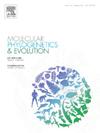Phylogenomic analyses re-evaluate the backbone of Corylus and unravel extensive signals of reticulate evolution
IF 3.6
1区 生物学
Q2 BIOCHEMISTRY & MOLECULAR BIOLOGY
引用次数: 0
Abstract
Phylogenomic analyses have shown that reticulate evolution greatly affects the accuracy of phylogenetic inferences, and thus may challenge the authority of bifurcating phylogenetic trees. In this study, we re-evaluated the phylogenetic backbone of the genus Corylus based on complete taxon sampling and genomic data. We assembled 581 single-copy nuclear genes and whole plastomes from 64 genome resequencing datasets to elucidate the reticulate relationships within Corylus. Nuclear coalescent and concatenation phylogenies revealed identical and fully supported backbone, clarifying the sisterhood between sect. Acanthochlamys and sect. Siphonochlamys as well as the phylogenetic position of C. fargesii and C. wangii, which have yet been addressed in previous phylogenetic studies. However, the monophyly of C. jacquemontii and C. kwechowensis and the distinction between C. ferox and C. ferox var. thibetica were not supported. Gene trees-species tree conflicts and cytonuclear discordance were identified, with multiple evidences supporting that hybridization/introgression, coupled with incomplete lineage sorting, have led to substantial phylogenetic incongruence in Corylus. Moreover, typical geographical clustering rather than strict monophyletic pattern in plastome phylogeny implies chloroplast capture within Corylus and offers evidence of cytoplasmic introgression. Overall, this study provides a robust phylogenomic backbone for Corylus and unravels that reticulate evolution can greatly shape taxonomic revision.

求助全文
约1分钟内获得全文
求助全文
来源期刊
CiteScore
7.50
自引率
7.30%
发文量
249
审稿时长
7.5 months
期刊介绍:
Molecular Phylogenetics and Evolution is dedicated to bringing Darwin''s dream within grasp - to "have fairly true genealogical trees of each great kingdom of Nature." The journal provides a forum for molecular studies that advance our understanding of phylogeny and evolution, further the development of phylogenetically more accurate taxonomic classifications, and ultimately bring a unified classification for all the ramifying lines of life. Phylogeographic studies will be considered for publication if they offer EXCEPTIONAL theoretical or empirical advances.

 求助内容:
求助内容: 应助结果提醒方式:
应助结果提醒方式:


